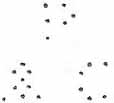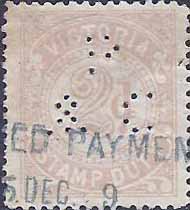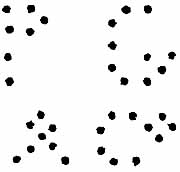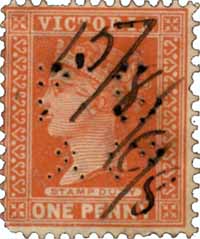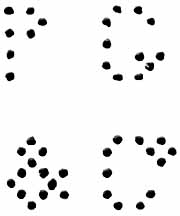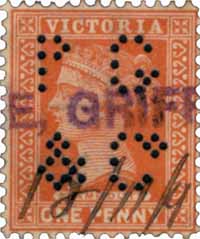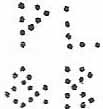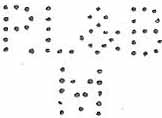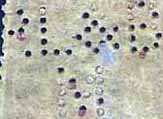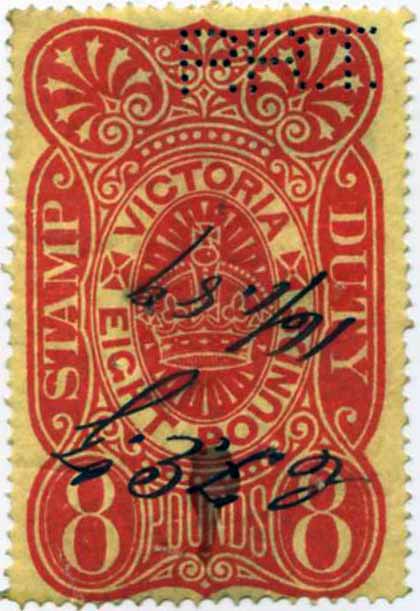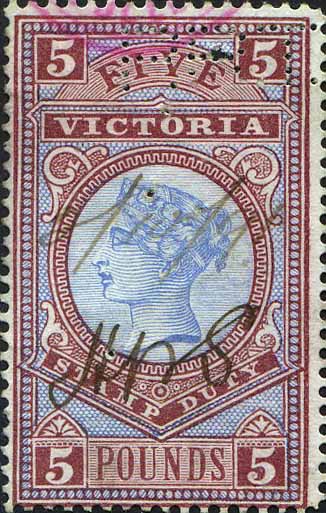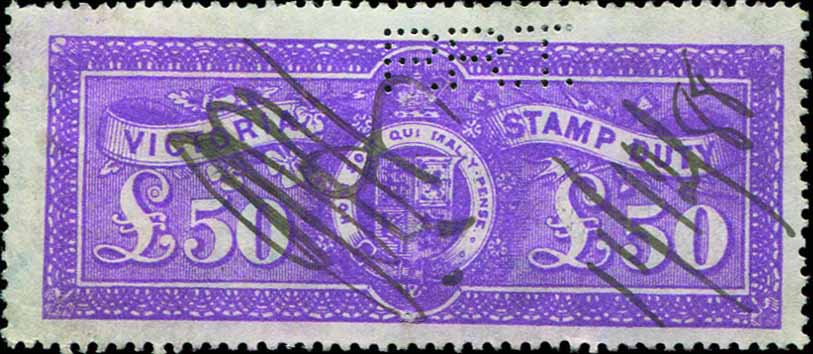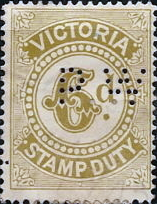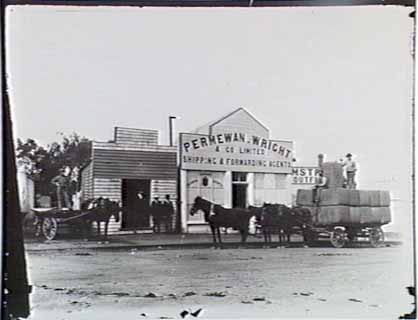|
Private Revenue Perfins of Victoria An Elsmore Coath production The authors would welcome your comments additions or input into this work A B C D E F G H I J K L M N O P Q R S T V W Y Other P -------------------------------------------------------- P/&C.a
User: Peterson & Co Pty Ltd Tea & Coffee Merchants Address: 348 Flinders St, Melbourne, VIC Revenue Use: 1915 2d Rarity Scale:
1915 Series 2d R4
Background: Refer McK/& C.a
Device: The P/&C.a pattern is made from a temporary die in a single die format. Such devices, which could produce these temporary patterns, were used by some Stamp Vendors in Melbourne from late 1800’s and early part of the 20th Century. This particular pattern is known over the period 1915-19. It is most commonly found on postage stamps. These P/&C patterns are found with extra pins on the bottom of the C that make for a more complete C. This variation is only reported on postage stamps. Related Patterns: Refer to other Peterson & Co Pty Ltd and related company patterns in: VIC: McK/&C.a and McK/&Co.a Peterson Invoice using McKenzie McK/&Co.a Perfin -------------------------------------------------------- P.G/&Co..a
User: Price, Griffith & Co Merchants Address: 522-536 Little Collins St, Melbourne, VIC Revenue Use: 1884 Stamp Duty Series: 1886-1899 Series, inscribed 'STAMP DUTY' 1d Rarity Scale:
1884 Series
1886-1899 Series, inscribed 'STAMP DUTY' 1d R4 Background: Alfred Davis Price, the son of a grocer, was born in 1856 in Columbus, Ohio, and migrated to Victoria with his family in 1859. By 1880, Alfred Price had formed a partnership with William Hobbs, and was trading as Price, Griffith & Co., possibly in the Ovens Valley. A year later, Price married William’s sister, Julia Hobbs, at Pleasant Creek (Stawell). For a brief period, from May, 1895, to October, 1897, Price and Griffiths were part of Innes, Noad, Price and Griffiths, merchants of William Street, Melbourne, who also sold small grocery and general businesses. Thereafter, the association appears to have been dissolved and the business reverted to being Price, Griffith & Co. with Alfred Price and William Hobbs as the sole partners. In 1897, Price, Griffith & Co are found at 516 (expanding to 522-536) Little Collins Street, a three storey bluestone warehouse, under C. Jeffereys as manager. In July, 1902, a fire broke out on the third floor, completely destroying everything on it. In November, 1914, fire (which started in the tobacco room) again severely damaged the building. In October, 1921, Price, Griffith & Co. opened a Geelong branch in Ryan Place, with W.R. Anderson jnr as manager. The branch closed in 1929. William Hobbs died at Kew in July, 1928, and was buried at Boroondara Cemetery. Alfred Davis Price of Price, Griffith & Co., “wine, spirit and general merchants” of 522 Little Collins Street, died at his Royal Park home in August, 1928. In December, 1929, Groves, McVitty & Co. Pty Ltd, merchants of 8-12 Market Street, Melbourne, bought Price, Griffith & Co., wholesale provisions merchants. P.E. Price, son of Alfred Davis Price, who began his career in his father’s business, accepted a seat on the board of Groves, McVitty & Co. Pty Ltd. The warehouse at 522-536 Little Collins Street, “lately occupied by Price, Griffith & Co.” was put up for sale in November 1930. For a number of years, before moving to Melbourne, Alfred Price had a residence in Daisy Street, Chilwell, (named after his daughter, Daisy) and was a member of Newtown and Chilwell Council (Geelong). Price, a keen philatelist, left “one of the finest stamp collections in the State”. He left real estate valued at £2,546 and personal property to the value of £84,287. See PG/&Co.a Device: The PG/&Co.a pattern has been provisionally assigned to the user Price Griffith & Co, but this has now been confirmed by the revenue company cachet showing a partial “..E, GRIFF…” on PG/&Co.b.
There are a total of 3 PG/&Co patterns found on the postage stamps of Victoria but only 2 are found used on revenue stamps.
The PG/&Co patterns are Temporary perfin patterns made by a Stamp Vendor. Although there are no known records of these Vendors in respect to specific patterns and users, proving pieces tend to support the view that the Vendors used a single alphabetic layout for each user, so all PG/&Co patterns can be attributed to Price Griffith & Co.
The PG/&Co.a pattern is very rare and is only found used on the postage and revenue stamps of Victoria in the period in the period around 1898. Related Patterns: Refer to other Price Griffith & Co patterns in: VIC: PG/&Co.b -------------------------------------------------------- P.G/&Co..b
User: Price, Griffith & Co Merchants Address: 522-536 Little Collins St, Melbourne, VIC Revenue Use: 1884 Stamp Duty Series: 1886-1899 Series, inscribed 'STAMP DUTY' 1d (shades) Rarity Scale:
1884 Series
1886-1899 Series, inscribed 'STAMP DUTY' 1d R4 Background: See PG/&Co.a Device: See PG/CO above.
The PG/&Co.b pattern is very rare and is only found used on the postage and revenue stamps of Victoria in the period in the period around 1898. Related Patterns: Refer to other Price Griffith & Co patterns in: VIC: PG/&Co.a -------------------------------------------------------- PL/&B.a
User: Paterson, Laing & Bruce Warehousemen. Later Department Store Address: 13-15 Flinders Lane, Melbourne, VIC Revenue Use: 1884
Stamp Duty Series: Rarity Scale:
1884
Stamp Duty Series: Background: *The origins of the company date back to 1850 when J. C. Young opened a small warehouse in Geelong. Later in 1852 after gold was discovered in Victoria, Young established a branch in Ballarat and appointed John Paterson as manager. The business was moved to Melbourne and Paterson was admitted to a partnership, the company then being known as J. C. Young & Co. There were further changes in the partnerships as follows; 1860 first being called Paterson, Palmer & Co, then, after the amalgamation with Ray Glaister & Co; as Paterson, Ray, Palmer & Co. In 1876 the company became Paterson Laing & Co. and then finally Paterson, Laing & Bruce with John Bruce joining the company in 1878. The Depression of the 1890’s were difficult times for the company but during this period Bruce managed to borrow substantial moneys to buy out his senior partner John Paterson and become the major shareholder. In 1900 the company opened a branch in Sydney however Bruce died in 1901 leaving the management of the company to his sons Earnest, in Australia and Stanley who lived in London. Initially in 1898 Paterson, Laing & Bruce Ltd was registered in London but on John Bruce’s death it was taken over by a newly registered Paterson, Laing & Bruce (1901) Ltd in July 1901, with the '1901' being taken out of the name in 1903. After completing his studies and experience with a commercial legal firm, Stanley was appointed acting Chairman in 1907 (confirmed in 1908) staying in London as this was still the seat of the companies other Directors, shareholder and financiers. By 1910 the company had become well established in Sydney and was growing in Melbourne. That year Stanley returned to Australia as General Manager as Ernest was overseas and they again exchanged positions in 1914 at the outbreak of World War I. Despite the war and the fact that both Earnest and Stanley were on active service, the company prospered. Stanley was discharged in 1917 as wounded and returned to Australia as general Manager and in April 1918 successfully won the Federal seat of Flinders for the National Party. He was later Prime Minister of Australia from 1923-1929. Bruce spent eight months of 1919 at head office in London. Ernest died that year, leaving Bruce to handle the two positions they had shared. He again went to London early in 1921 but by 1922 he was made Treasurer and his political career had eclipsed his business and he handed over the running of the company to his solicitor to Thomas Alston. In the 1929 election Bruce lost his seat and his Prime ministership and turned his attention to his business that was under growing pressure. Although re elected in the next election in 1931 he spent most of his time abroad on various appointments including High Commissioner in London but retired from Australian politics in 1945. In 1947 New Year honour’s Bruce received a viscountcy, and chose to be Bruce of Melbourne and took a seat in the English House of Lords as well as accepting various directorships, mainly with Australian companies. Bruce continued to live in London where he died on 25 August 1967. In Feb 1966 the company was merged with Robert Reid & Co Ltd into Paterson, Reid & Bruce Ltd. Device: Patterson Laing and Bruce were major perfin users and there are more than 30 different patterns attributed to them. Most of these were used in Melbourne and most were Temporary Punctures. That is temporary dies created to apply a pattern to a stamp purchased from a stamp vendor.
PL/&B.a was one of these Temporary patterns and there were approximately 24 others in the PL/B, PL/&B formats that are found on postage stamps. However PL/&B.a is the only Temporary pattern from this user that is found on Revenue stamps.
Patterns in the particular style, scale and layout of PL/&B.a were produced over the period 1896 until 1901 but these all vary in separation and completeness of letters etc.. In total 7 different settings of the pattern have been reported to date on postage stamps but only a single setting on revenue stamps. Related Patterns: Refer to other Patterson, Laing or Bruce company patterns in: VIC: PL&B/M.a NSW: PL/&B.a *TROVE ------------------------------------------------------- P.L&B/M.a
User: Paterson, Laing & Bruce Warehousemen Address: 13-15 Flinders Lane, Melbourne, VIC Revenue Use: 1884
Stamp Duty Series: 1886-1899 Series, inscribed 'STAMP DUTY' 1d (shades) Rarity Scale:
1884
Series
1886-1899 Series 1d R4 Background: See PL/&B.a above Device: As noted in PL/&B.a above, Patterson Laing and Bruce were major perfin users and there are more than 30 different patterns attributed to them. Most of these were used in Melbourne and most were Temporary Punctures. That is temporary dies created to apply a pattern to a stamp purchased from a stamp vendor.
The Melbourne office had at least 5 customised devices between 1896 and the 1940’s and their usage overlaps considerably.
The P.L&B/M.a device was one of these and it seems to have been used rather haphazardly, on both revenue and postage stamps. Usage starts in 1900, possibly earlier, but usage after this time is much rarer.
The rarer later usage may be due to the condition of the device as all post circa 1900 examples in the Commonwealth period feature many missing pins or imperfect strikes.
The device stayed in use until about 1934 but usage after the early 1900’s is rare.
Related Patterns: Refer to other Patterson, Laing or Bruce company patterns in: VIC: PL&B.a NSW: PL/&B.a -------------------------------------------------------- P.R.T..a
User: Pentland, Roberts & Thompson Solicitors Address: 90 Chancery Lane, Melbourne, VIC Note: Chancery Lane was the name for the Lane that ran between William and Queen Sts. It was later renamed as Little Collins St. Revenue Use: 1879
Series 2/6d, 3/-, £8, £50 1886-1899
Series, inscribed 'STAMP DUTY' 1d (shades), 1/-,
£5 Rarity Scale:
1879 Series 2/6d R3, 3/- R4, £8 R4, £50 R4
1886-1899 Series 1d R4, 1/- R3, £5 R5
Background: *The legal practice of Pentland, Roberts and Thompson was founded by William Pentland in 1853 in Smythe’s Building, in Chancery Lane. Initially, he advertised as handling marine law, equity and conveyancing, but soon expanded to include other legal areas. Pentland frequently represented Williamstown Council and stood, unsuccessfully for parliament in 1871.
William Pentland was born in Armagh, Ireland in 1807; educated in Westminster, he afterwards became a leading Dublin solicitor. Disliking the profession, he went to America where he stayed for 5 years during which time he assisted the great American novelist Henry James in writing romances.
Returning briefly to Ireland, Pentland migrated to Victoria in late 1853, living in the city for a few months before moving permanently to Cecil Street, Williamstown. William Pentland died on 16 September, 1882, “leaving behind him an honest name and many will miss his kindness”. He was remembered as “ever bright and pleasant with a jovial wit, brimming over with mirth and poetry” and a practitioner of charity.
In 1872, William Pentland admitted William Henry Roberts as a partner in the practice. Articled to Pentland in 1863, Roberts was already well known to Pentland having been born in 1847 in Williamstown where he was also educated. Roberts was admitted to the Supreme Court as an Attorney in 1871. He was a Member of the Legislative Council (North Yarra Province) in 1892 and also a Williamstown Councillor (1874-76). William Henry Roberts died at his home in Albert Park in 1900. The legal practice ended with his death.
The legal practice briefly became Pentland, Roberts and Thompson from 1886 to 1891. James Ratu Thompson was admitted as a partner to the firm in July, 1886. The association appears to have been an unhappy one, Thompson moving to the Footscray office in the same year.
In September, 1892, Thompson was advertising himself as “late of Pentland, Roberts and Thompson” commenced practice in the Older Fleet building in Collins Street and attending Williamstown Court two days a week. In May of the same year, he had tried practising at Maryborough, apparently without success. By December, 1892, he was working at Catterall and Shallard’s practice in Footscray. Thompson was sued by a client in 1894 and again in 1911. James Ratu Thompson died insolvent in 1923. In previous studies of Australian Private Perfins this pattern has been only provisionally assigned to the user Pentland, Roberts & Thompson. However our study of their revenue use shows that the usage of high values and the frequency of revenue cancellations from the Titles Office and similar, provides enough evidence that the user is a Solicitor. Furthermore the history of the company and its name changes sits very well with the usage period of the device. Device: The PRT.a device is a customised single die device. This can be confirmed by the fact that it is found with single and central strikes in stamps of various formats.
The device came into service in 1888, shortly after Thompson joined the firm, and remained in service until at least 1892, notably when Thompson left the firm.
Given the relatively short period of use it is a rare pattern on both the postage and the revenue stamps of Victoria.
Related Patterns: Nil
* J O’Donnell research
Williamstown Chronicle,23 September, 1882, p.3.
-------------------------------------------------------- P.W.a
User: Permewan, Wright & Co Ltd Produce Merchants in NSW. Customs Forwarding Agents in VIC Address: 120 Collins Street, Melbourne, VIC Doveton Street, Ballarat, VIC Revenue Use: 1886-1899 Series, inscribed 'STAMP DUTY' 1d (shades), 2d, 3d, 6d 1902 Series 1d, 6d (Bistre) 1911 Series 1d, 6d (Violet) Rarity Scale:
1886-1899 Series 1d R4, 2d R4, 3d R4, 6d R4
1902 Series 1d R2, 6d R4
1911 Series 1d R4, 6d R3 Background: *John Permewan, was born in Penzance, Cornwall, England, in 1837 and immigrated to Ballarat, Victoria in the early 1850’s. He joined the carriers and commission agents company, Browne, Osborne & Co who operated between Geelong and Ballarat. Permewan became a partner in 1861 but that same year the partnership split with Browne and Osborne forming their separate companies, Browne, Sons & Co. and T. Osborne & Co., respectively. Permewan joined T. Osborne & Co and carried on business until 1869 when he joined with E. Hunt to form Permewan Hunt & Co. In 1876 Hunt retired and J. E. Wright joined the company and it became Permewan Wright & Co. It became a limited company in 1879. (Some sources 1884). The business grew through expansion and acquisition. In July 1875 they acquired Coghill's and the Wagga Wagga Steam Navigation Co. and this gave them a large share of the Murray trade centred in Echuca. They then expanded into the Darling and Murrumbidgee Rivers and by 1888 Permewan Wright had 48 branches in Victoria and New South Wales and agencies at almost every railway station. They established a 3 storey warehouse in Collins St, Melbourne and their London agent, Pickford & Son, linked them to an extensive international trade. The company expanded its road cartage network in addition to commissioning two cargo and three passenger steamers, which ran between Geelong and Melbourne. The Depression of the 1890s forced many agents, and river traders out of business and this only served to strengthen Permewan Wright & Co. John Permewan remained as head of the company until failing health forced him to retire in 1902. He died at his home in Ballarat on 23 December 1904 aged 67, survived by his wife Isabelle nee Towers, and by a son and a daughter. The company name changed to Permewan Wright Ltd in 1927; and the business was redirected into wholesale hardware and later the company became a broadly based chain of supermarkets, after a merger with Grocery & General Merchants Ltd. They had branches in major NSW and Victorian towns including Dubbo, Beulah, Hamilton, Mildura, and Warragul and others. They later acquired the Victorian, NSW and Tasmanian grocery chain Moran and Cato in 1969. Device: The PW.a device is a single die device, which is found used on the revenue and postage stamps of NSW and Victoria and later the postage stamps of Australia, collectively from at least 1895 until about 1925. Evidence from postmarks on postage stamps indicates that usage was widespread, mainly across Victoria, and the usage in NSW overlaps with the Victorian usage. This can sometimes be explained by cross State usage but this is only in the period around 1912 when the Post Offices were looking to use up State issues prior to the issuing of the first Australian stamps in 1913. The patterns found on all these remote usages are exactly the same. It is possible that this was through the use of a series of identical devices, but in such instances there are small differences in the pattern, different wear characteristics, consistent missing pins and the like that lead to the identification of specific devices/patterns to particular locations. However this is not the case with the PW.a pattern and we consider that it is more likely that the stamps were punctured centrally and that they were distributed for use in the company’s various offices. Related Patterns: Refer to other Permewan Wright and related company patterns in: NSW: PLD.a, PW.a *Australian Dictionary of Biography *State Library of Victoria
-------------------------------------------------------- A B C D E F G H I J K L M N O P Q R S T V W Y Other © copyright 2011 |
